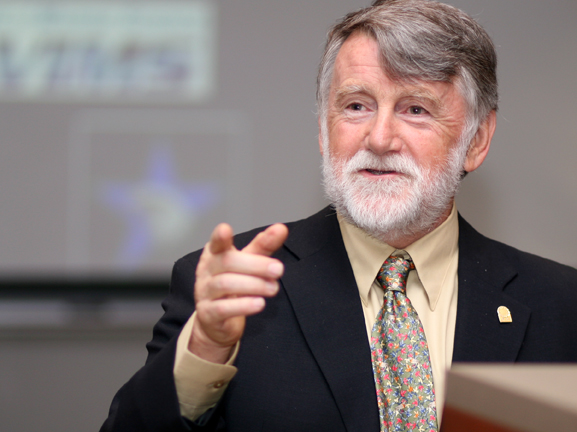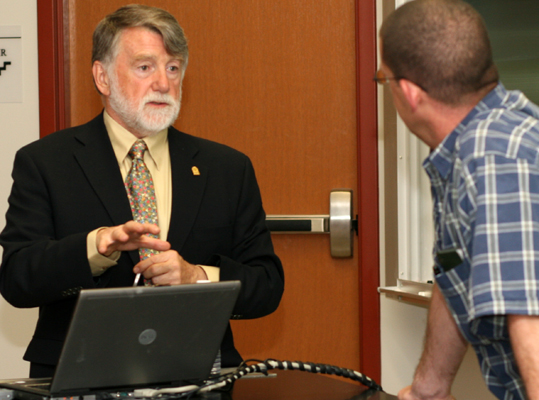 If you think research on the Chesapeake Bay has no connection to the Midwest, Dennis Whigham ’66 says you're wrong.
If you think research on the Chesapeake Bay has no connection to the Midwest, Dennis Whigham ’66 says you're wrong.
"It’s totally relevant," the Smithsonian Environmental Research Center senior scientist from Annapolis, Maryland told faculty and students gathered in Hays Hall Wednesday for the Fifth Annual Thomas Cole Lecture. Whigham noted that the Chesapeake Bay was like a microcosm of the more expansive Mississippi River watershed, fed in part by streams here in Indiana, has helped to create an oxygen-starved "dead zone" near the river’s entrance into the Gulf of Mexico.
"This is being caused by what’s happening here in the Midwest, right here in Indiana," Whigham explained. The ecologist’s decades of studying the Chesapeake, and the steps he and others are taking to prevent further damage and restore water quality there, shed light on what can be done right here for our streams and the Ohio, Mississippi and the Gulf of Mexico.
Much of Whigham’s research on Chesapeake Bay has focused on finding and measuring indicators of the bay’s "health"—water quality, wildlife diversity, and the quality of the fisheries that, until the 1980s, were an economic driver for the region.
"If you’re going to manage the water resource, you have to go to the source of the problem," Whigham explained. "You have to do things on land to protect your aquatic resource."
For example, concentrations of nitrates in the water are one indicator of poor water quality, caused, in part, by run-off from farm fields where nitrogen fertilizer is used.
"But the Chesapeake is the nation’s largest estuary, and trying to show direct linkages in such a vast system has been difficult," Whigham explained.
Part of his task in working with the Atlantic Coast Consortium and other groups has been to develop more precise and detailed ways of collecting data that can establish those links between sources and effects.
Among the tools he uses are ecological modeling methods developed by Smithsonian senior scientist Don Weller ’74—another Wabash graduate—which use spatial analysis and statistics to better understand how nitrates and other excess nutrients enter the landscape and move through it to affect aquatic resources like the Chesapeake Bay.
One such method, called "estuarine segmenting," divides the more than 11,000 miles of coastline into smaller sections based on the streams and other sources feeding that section, utilizing detailed mapping to determine how land is being used and water quality data from hundreds of gathering points.
The results have yielded some surprises.
 It turns out that run-off from land development for housing, roads, stores, factories, and other commercial applications is, Whigham said, "actually more destructive to water quality than agriculture."
It turns out that run-off from land development for housing, roads, stores, factories, and other commercial applications is, Whigham said, "actually more destructive to water quality than agriculture."
This has major implications, he noted, when you take into consideration the increasing migration of people toward the coasts.
While the work of Whigham and others illuminates the threat of development to coastal water quality, it also suggests a solution.
"We can now see just how much development, actually figure a percentage of the land you can have in development in a specific area, before you adversely affect the water quality," Whigham explained. Such information could help federal, state, and local officials establish guidelines for development to preserve those areas not yet impacted, and restore those areas already damaged.
Whigham described several projects in the Chesapeake Bay area which are having success in this way, and he is using a similar model in a study in Alaska to prevent a pristine salmon stream from suffering the degradation he’s seen so often in the lower 48 states.
But the solutions aren’t necessarily large-scale projects. The scientist showed how individuals and groups are adding rain gardens, ponds, and even high tech versions of the old rain barrel (Whigham uses them at his own home) to minimize runoff and improve water quality downstream.
Whigham concluded on a hopeful note:
"We can use this information to make the best choices to bring our waterways back from the threshold of destruction."
Whigham will present a talk on his research into "interactions between terrestrial orchids and mycorrhizal fungi - complexities at varying scales" Thursday at noon in Hays Hall 104.
Photo, lower left: Whigham talks with Wabash biology professor Eric Wetzel.